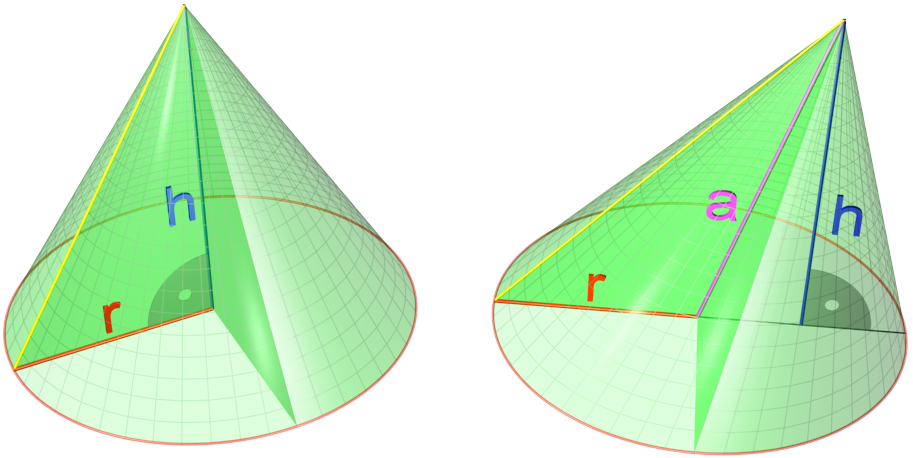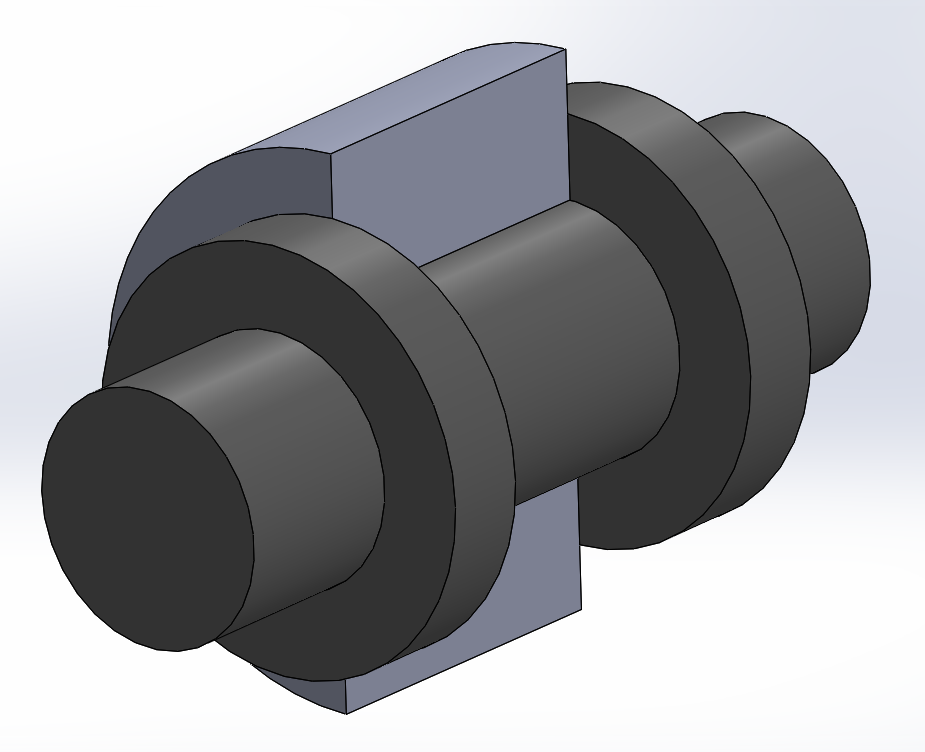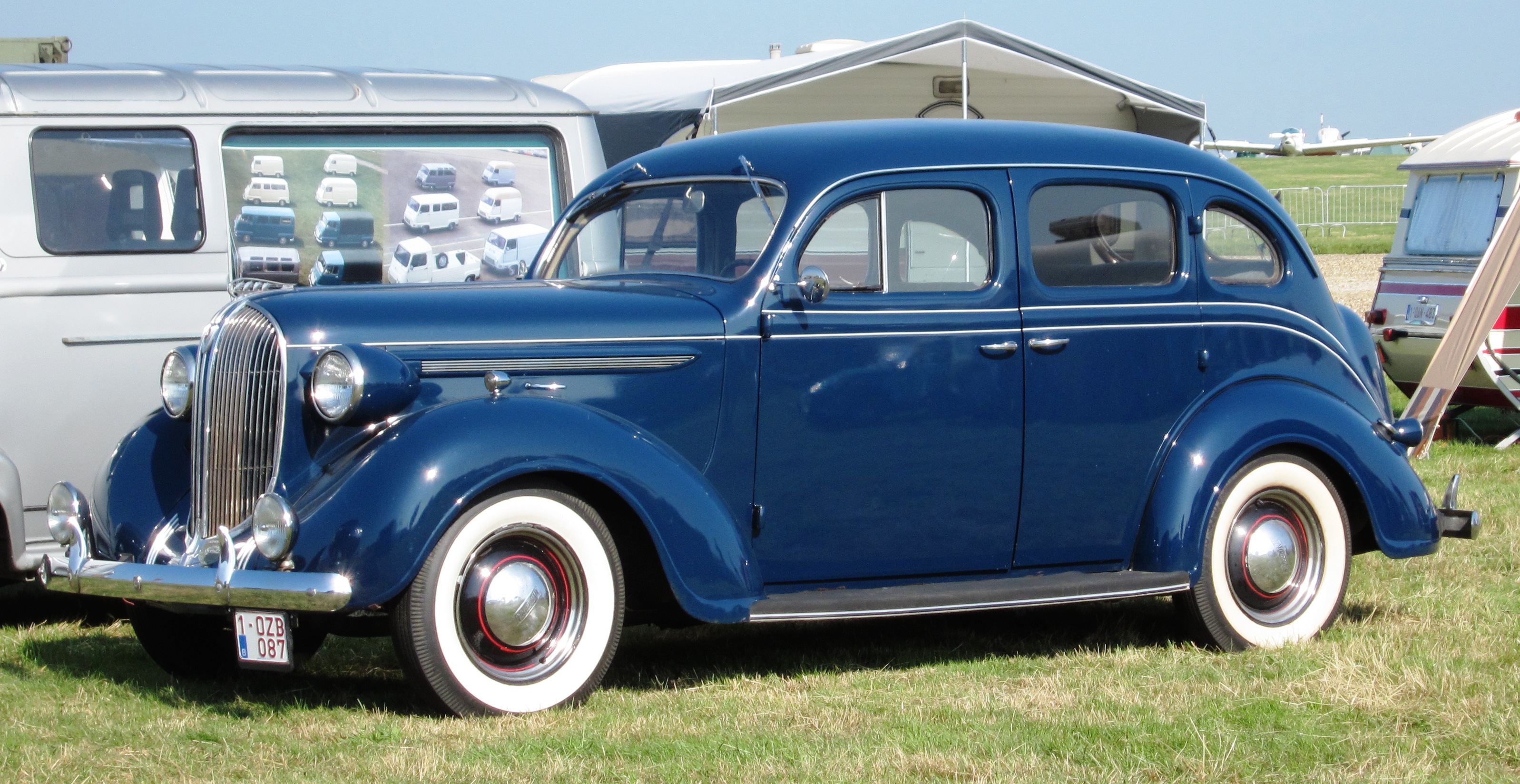|
Ausco Lambert Disc Brake
The Ausco-Lambert disc brake is an unusual brake where an axially-expanding shoe assembly is sandwiched between two linked rotating discs. It may be thought of as an "inside out" disc brake: instead of pads pinching a disc, the pads expand inside a hollow disc. History Ausco-Lambert brakes were introduced in late 1948 and used commercially in some Chrysler cars and some Farmall tractors. The 1950 Crosley Hot Shot is often given credit for the first production disc brakes but the Chrysler Imperial actually had them first as standard equipment at the beginning of the 1949 model year. The Crosley disc was a Goodyear development, a caliper type with ventilated rotor, originally designed for aircraft applications. Only the Hot Shot featured it. Lack of sufficient research caused enormous reliability problems, especially in regions requiring the use of salt on winter roads, such as sticking and corrosion. Drum brake conversion for Hot Shots was quite popular. The Chrysler 4-wheel di ... [...More Info...] [...Related Items...] OR: [Wikipedia] [Google] [Baidu] |
Brake
A brake is a machine, mechanical device that inhibits motion by absorbing energy from a moving system. It is used for Acceleration, slowing or stopping a moving vehicle, wheel, axle, or to prevent its motion, most often accomplished by means of friction. Background Most brakes commonly use friction between two surfaces pressed together to convert the kinetic energy of the moving object into heat, though other methods of energy conversion may be employed. For example, regenerative braking converts much of the energy to electrical energy, which may be stored for later use. Other methods convert kinetic energy into potential energy in such stored forms as Compressed air energy storage, pressurized air or pressurized oil. Eddy current brakes use magnetic fields to convert kinetic energy into electric current in the brake disc, fin, or rail, which is converted into heat. Still other braking methods even transform kinetic energy into different forms, for example by transferring the en ... [...More Info...] [...Related Items...] OR: [Wikipedia] [Google] [Baidu] |
Chrysler Town & Country (1941–1988)
The Chrysler Town & Country is an automobile which was manufactured by Chrysler (division), Chrysler from 1940 to 1942 and from 1945 to 1988 with production interrupted during World War II. Primarily produced as a Luxury car, luxury station wagon, the Town & Country was also available in "woodie (car body style), woodie" four-door sedan (car), sedan, two-door hardtop and convertible body styles from 1947 to 1950, 1968 to 1969 and from 1983 to 1986. The 1988 model year was the last for the station wagon until the 1990 model year when Chrysler reintroduced the Town & Country nameplate as the badge engineering, rebadged variant Chrysler Town & Country minivan. Chrysler's Town & Country wagon was reintroduced with all-steel construction in 1951, in both Windsor and New Yorker variants through the end of Windsor model production for the 1960 model year, and then in Newport and New Yorker models through 1965. In 1966 it became a stand-alone model, with trim and features which bridged the ... [...More Info...] [...Related Items...] OR: [Wikipedia] [Google] [Baidu] |
Drum Brake
A drum brake is a brake that uses friction caused by a set of Brake shoe, shoes or Brake pad, pads that press outward against a rotating bowl-shaped part called a brake drum. The term ''drum brake'' usually means a brake in which shoes press on the Brake lining, inner surface of the drum. When shoes press on the outside of the drum, it is usually called a ''Railway brake, clasp brake''. Where the drum is pinched between two shoes, similar to a conventional disc brake, it is sometimes called a ''pinch drum brake'', though such brakes are relatively rare. A related type called a band brake uses a flexible belt or "band" wrapping around the outside of a drum. History The modern automobile drum brake was first used in a car made by Wilhelm Maybach, Maybach in 1900, although the principle was only later patented in 1902 by Louis Renault (industrialist), Louis Renault. He used woven asbestos lining for the drum brake lining, as no alternative material dissipated heat more effectivel ... [...More Info...] [...Related Items...] OR: [Wikipedia] [Google] [Baidu] |
Brake Fade
Brake fade (or vehicle braking system fade) is the reduction in stopping power that can occur after repeated or sustained application of the brakes of a vehicle, especially in high load or high speed conditions. Brake fade can be a factor in any vehicle that uses a friction braking system including automobiles, trucks, motorcycles, airplanes, and bicycles. Brake fade is caused by a buildup of heat in the braking surfaces and the subsequent changes and reactions in the brake system components and can be experienced with both drum brakes and disc brakes. Loss of stopping power, or fade, can be caused by friction fade, mechanical fade, or fluid fade. Brake fade can be significantly reduced by appropriate equipment and materials design and selection, as well as good cooling. Brake fade occurs most often during high performance driving or when going down a long, steep hill. It is more prevalent in drum brakes due to their configuration. Disc brakes are much more resistant to brake fa ... [...More Info...] [...Related Items...] OR: [Wikipedia] [Google] [Baidu] |
Divot
The following is a glossary of the terminology currently used in the sport of golf. Where words in a sentence are also defined elsewhere in this article, they appear in italics. Old names for clubs can be found at Obsolete golf clubs. 0–9 ; : The clubhouse bar. A B ;Bag ; Ball: A small sphere used in playing golf, which is intended to be struck by a player swinging a club. Balls are usually white, covered in dimples, and made of a variety of materials. ; Ball-marker: A token or a small coin used to spot the ball's position on the green prior to lifting it. ; Ball retriever ; Ballstriking: the combination of a golfer's driving and approach play (i.e. long game), as opposed to '' short game'' ; Ball washer: A device found on many tees for cleaning golf balls. ; Banana-ball: The result of a severe slice that results in a trajectory in the shape of a banana. This is also referred to as an extreme slice. ; Bandi ... [...More Info...] [...Related Items...] OR: [Wikipedia] [Google] [Baidu] |
Cone (geometry)
In geometry, a cone is a three-dimensional figure that tapers smoothly from a flat base (typically a circle) to a point not contained in the base, called the '' apex'' or '' vertex''. A cone is formed by a set of line segments, half-lines, or lines connecting a common point, the apex, to all of the points on a base. In the case of line segments, the cone does not extend beyond the base, while in the case of half-lines, it extends infinitely far. In the case of lines, the cone extends infinitely far in both directions from the apex, in which case it is sometimes called a ''double cone''. Each of the two halves of a double cone split at the apex is called a ''nappe''. Depending on the author, the base may be restricted to a circle, any one-dimensional quadratic form in the plane, any closed one-dimensional figure, or any of the above plus all the enclosed points. If the enclosed points are included in the base, the cone is a solid object; otherwise it is an open surface ... [...More Info...] [...Related Items...] OR: [Wikipedia] [Google] [Baidu] |
Brake Pad
Brake pads are a component of disc brakes used in automotive and other applications. Brake pads are composed of steel backing plates with friction material bound to the surface that faces the disc brake rotors. Function Brake pads convert the kinetic energy of a vehicle to thermal energy through friction. Two brake pads are contained in the brake with their friction surfaces facing the rotor. When the brakes are hydraulically applied, the caliper clamps or squeezes the two pads together onto the spinning rotor to slow and stop the vehicle. When a brake pad heats up due to contact with the rotor, it transfers small amounts of its friction material onto the disc, leaving a dull grey coating on it. The brake pad and disc (now both having the friction material), then "stick" to each other, providing the friction that stops the vehicle. In disc brakes, there are usually two brake pads per disc rotor, they both function together. These are held in place and actuated by a caliper affi ... [...More Info...] [...Related Items...] OR: [Wikipedia] [Google] [Baidu] |
Mechanism (engineering)
In engineering, a mechanism is a Machine, device that transforms input forces and movement into a desired set of output forces and movement. Mechanisms generally consist of moving components which may include Gears and gear trains; belt drive, Belts and chain drives; Cam (mechanism), cams and cam follower, followers; Linkage (mechanical), Linkages; Friction devices, such as brakes or clutches; Structural components such as a frame, fasteners, bearings, springs, or lubricants; Various machine elements, such as splines, pins, or keys. German scientist Franz Reuleaux defines ''machine'' as "a combination of resistant bodies so arranged that by their means the mechanical forces of nature can be compelled to do work accompanied by certain determinate motion". In this context, his use of ''machine'' is generally interpreted to mean ''mechanism''. The combination of force and movement defines Power (physics), power, and a mechanism manages power to achieve a desired set of forces and ... [...More Info...] [...Related Items...] OR: [Wikipedia] [Google] [Baidu] |
Wheel Cylinder
A wheel cylinder is a component of a hydraulic drum brake system. It is located in each wheel and is usually positioned at the top of the wheel, above the shoes. Its function is to exert force onto the shoes so as to bring them into contact with the drum and stop the vehicle with friction. The wheel cylinders are usually connected to the shoes with small bird-beak shaped rods. Wheel cylinders were first invented by Bendix in 1958. It is very similar to a slave cylinder and functions in much the same way, internally consisting of only a simple plunger. On older vehicles, these may begin to leak and hinder the performance of the brakes. They are, however, normally inexpensive and relatively easy to replace. The wheel cylinder consists of a cylinder that has two pistons, one on each side. Each piston has a rubber seal and a shaft that connects the piston with a brake shoe. When brake pressure is applied, the pistons are forced out, pushing the shoes into contact with the drum. Som ... [...More Info...] [...Related Items...] OR: [Wikipedia] [Google] [Baidu] |
Disc Brake
A disc brake is a type of brake that uses the #Calipers, calipers to squeeze pairs of #Brake pads, pads against a disc (sometimes called a [brake] rotor) to create friction. There are two basic types of brake pad friction mechanisms: abrasive friction and adherent friction. This action slows the rotation of a shaft, such as a vehicle axle, either to reduce its rotational speed or to hold it stationary. The energy of motion is converted into heat, which must be dissipated to the environment. Hydraulic brakes, Hydraulically Actuator, actuated disc brakes are the most commonly used mechanical device for slowing motor vehicles. The principles of a disc brake apply to almost any rotating shaft. The components include the disc, master cylinder, and caliper, which contain at least one cylinder and two Brake pad, brake pads on both sides of the rotating disc. Design The development of disc-type brakes began in England in the 1890s. In 1902, the Lanchester Motor Company designed bra ... [...More Info...] [...Related Items...] OR: [Wikipedia] [Google] [Baidu] |
Plymouth (automobile)
Plymouth was a brand of automobiles produced by Chrysler, Chrysler Corporation and its successor Mercedes-Benz Group, DaimlerChrysler. The brand was launched in 1928 to compete in what was then described as the "low-priced" market segment that was dominated by Chevrolet and Ford Motor Company, Ford. It became a high-volume seller for the automaker until the late 1990s. Plymouth cars were marketed primarily in the United States. The brand was withdrawn from the marketplace in 2001. The Plymouth models that were produced up until then were either discontinued or rebranded as Chrysler or Dodge. History Origins The Plymouth automobile was introduced at Madison Square Garden (1925), Madison Square Garden on July 7, 1928. It was Chrysler Corporation's first entry in the low-priced field previously dominated by Chevrolet and Ford. Plymouths were initially priced higher than the competition, but offered standard features such as internal expanding hydraulic brakes that Ford and Chevr ... [...More Info...] [...Related Items...] OR: [Wikipedia] [Google] [Baidu] |
Goodyear Tire And Rubber Company
The Goodyear Tire & Rubber Company is an American multinational tire manufacturer headquartered in Akron, Ohio. Goodyear manufactures tires for passenger vehicles, aviation, commercial trucks, military and police vehicles, motorcycles, recreational vehicles, race cars, and heavy off-road machinery. It also licenses the Goodyear brand to bicycle tire manufacturers, returning from a break in production between 1976 and 2015. As of 2017, Goodyear is one of the top five tire manufacturers along with Bridgestone (Japan), Michelin (France), Pirelli (Italian) and Continental AG, Continental (Germany). Founded in 1898 by Frank Seiberling, the company was named after American Charles Goodyear (1800–1860), inventor of Vulcanization, vulcanized rubber. The first Goodyear tires became popular because they were easily detachable and required little maintenance. Though Goodyear had been manufacturing airships and balloons since the early 1900s, the first Goodyear Blimp, Goodyear advertising ... [...More Info...] [...Related Items...] OR: [Wikipedia] [Google] [Baidu] |







